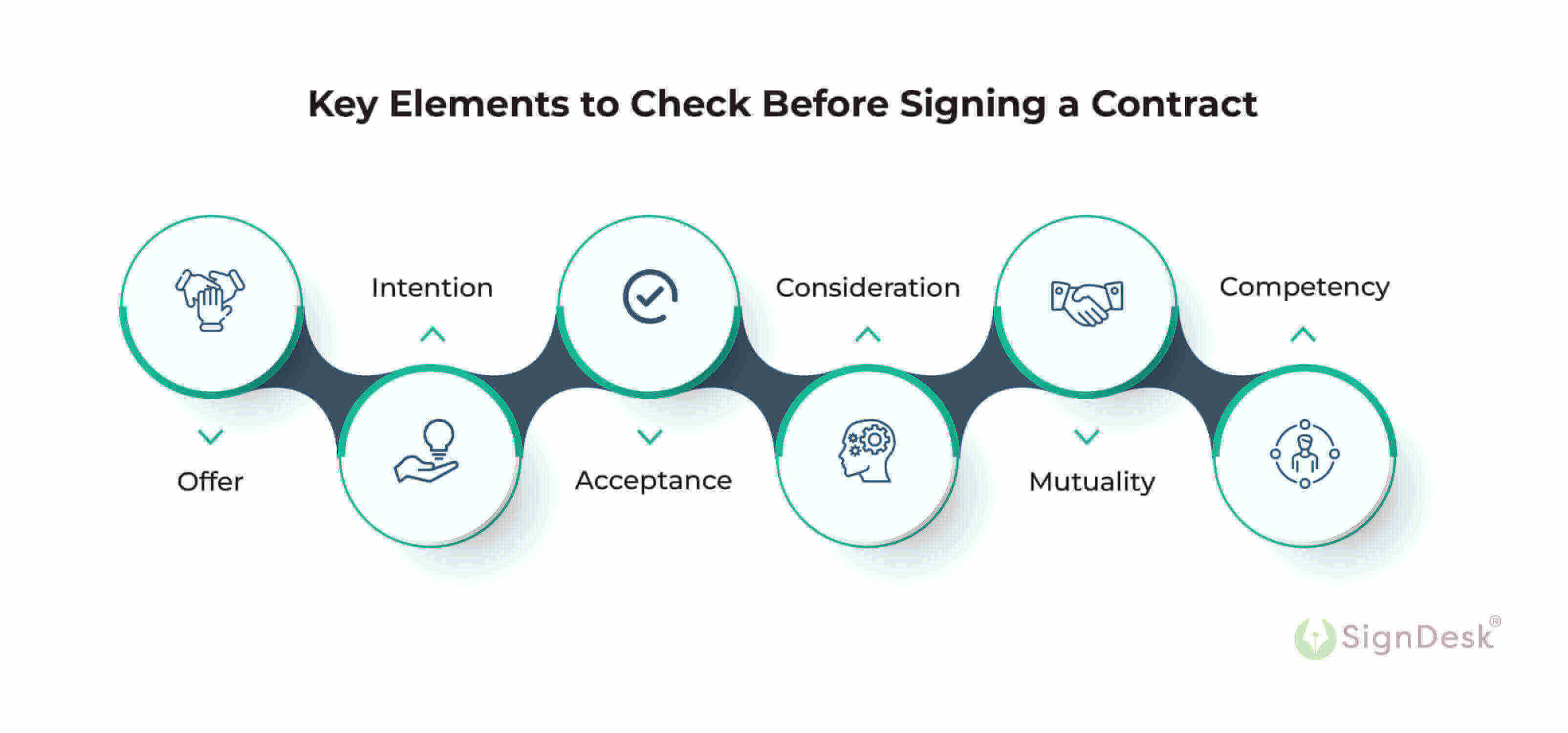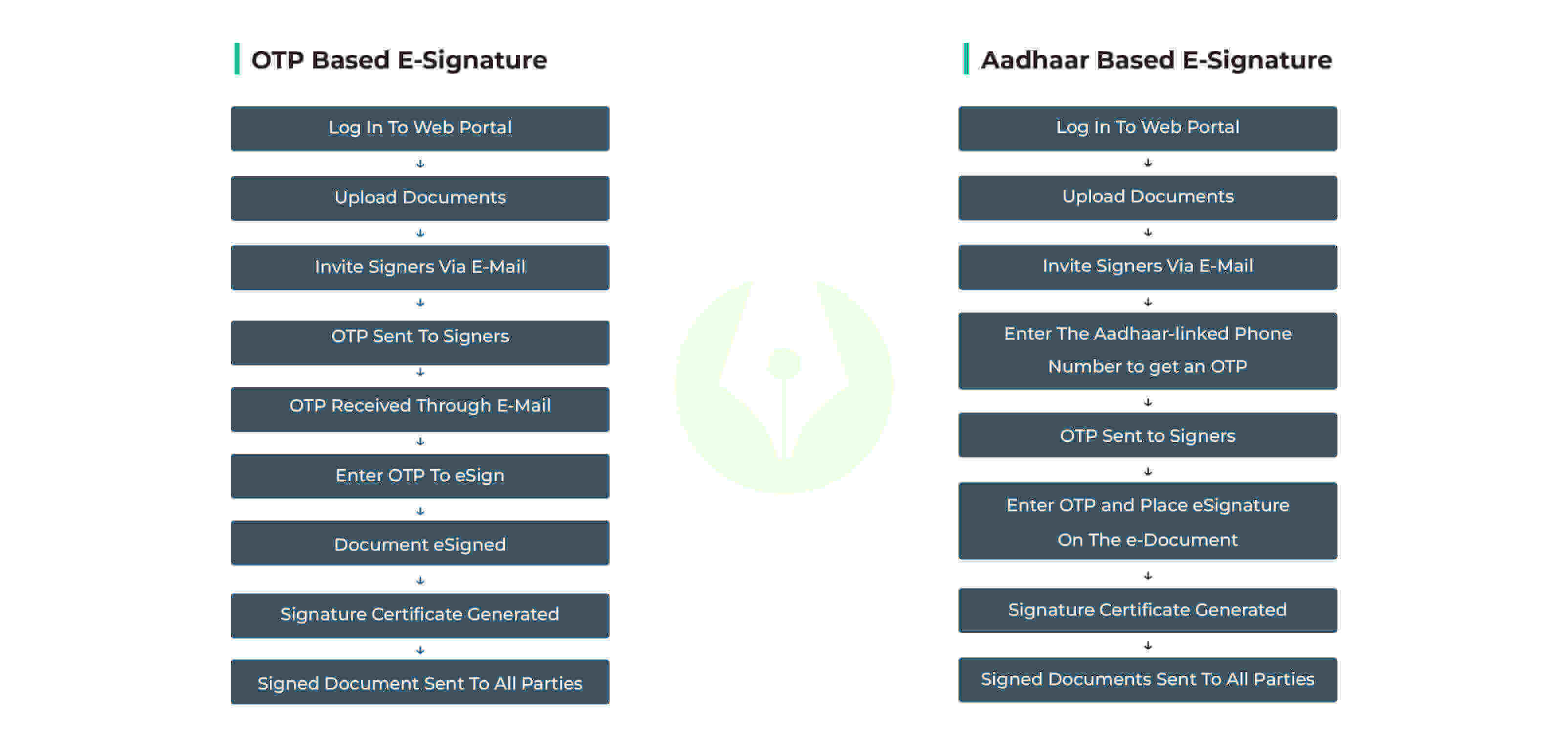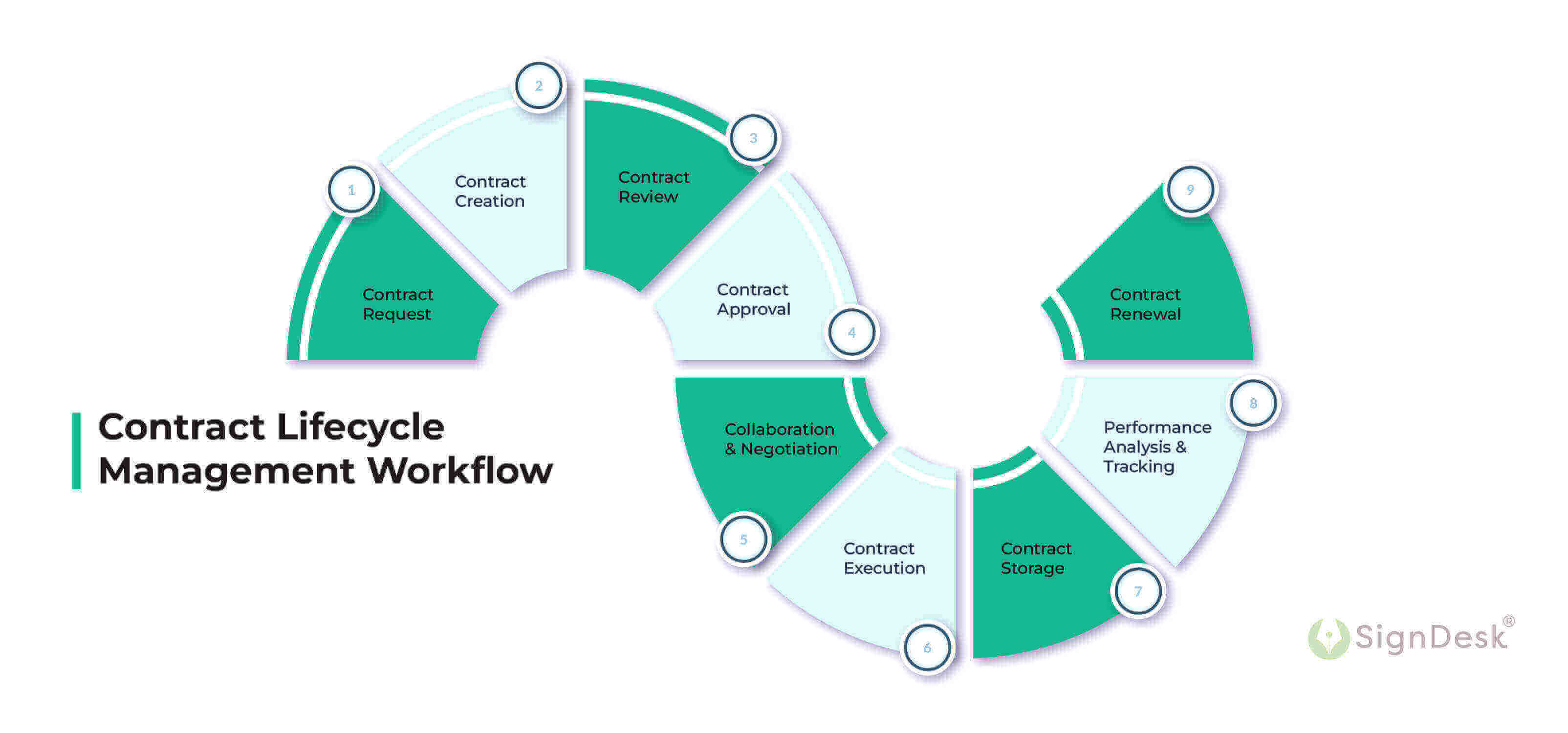A Brief Overview Of Signing Of Contracts
The signing of contracts is not only a ubiquitous activity but also a powerful legal act that indicates contractual terms and conditions have been consented to and act as evidence.
Without a valid signed contract, the risks of forgery, fraud, and legal problems down the line are massive. The conventional signature process is often expensive & time-consuming for businesses. Written signatures are also prone to security and data risks like manual errors, physical damage of signed papers, fabrication, and lost documents.
The signing of contracts online is rapidly gaining popularity with the increasing use of electronic signatures. Value-based contract management tools can streamline the eSign workflow and help procure signed contracts instantly.
AI-powered Contract Lifecycle Management (CLM) automates the signing of contracts in a paperless digital environment. The smart dashboard of the CLM software helps the client to compose contracts instantly with clause and template libraries, collaborate online with speedy negotiation cycles, sign contracts online with remote access anytime, and monitor contracts through every stage on the platform.
In the era of digital transformation, organizations are gradually shifting from manual to digital workflows. Online signing of contracts accelerates business growth, lowers operational costs, and improves productivity.
What Is A Signature – Legal Perspectives
According to Article 7 of the UNCITRAL Model Law on Electronic Commerce, 2001, a signature is a process that procures sufficient evidence to identify the person associated with it along with the content of a document and to provide certainty to the personal involvement of that person in the act of signing an agreement.
The form or record of a signature is usually the signatory’s name, written in the signatory’s own handwriting on a paper document which is known as a “manuscript signature” with variations ranging from simple modifications such as crosses or initials through pseudonyms and identifying phrases, symbols, or a logical alteration of information content, to printed names and rubber stamps.
In a legal signing setting, the legitimacy of a valid signature can be resolved with proper inspection by drawing out an analogy with the associated manuscript signature. This is usually accomplished by witnessing the signature being re-created by the signatory.
The primary function of a signature in contract is to provide evidence of the following.
- The identity of the signatory
- Intention to make a signature
- Adaption of document contents by the signatory
- Validating official action
- Protecting legal rights
An agreement can become a contract only if it is legally enforceable by law or fulfills the conditions laid down under section 10 of the Indian Contract Act of 1872. It states that a contract is basically an agreement, oral or written, between two or more parties that define rights, duties, and obligations which each party has to perform. A signature is evidence of acceptance of an agreement.
Section 10 of the Indian Contract Act enumerates the key elements that make a valid contract as follows
- Offer
- Acceptance
- Intention to Create Legal Relationship
- Lawful Object and Lawful Consideration
- Consideration should not be forbidden by law
- Capacity to Contract
- Possibility of Performance
- Legal Formalities
- Free consent
Definition Of Electronic Signature
As the signing of contracts has moved into paperless electronic formats, the criteria for the definition of a signature have been substantially broadened. There is a huge demand for a reassessment of what constitutes a valid signature with the increasingly widespread use of electronic communications.
The term “Electronic signature” refers to data in electronic form, affixed to, or logically associated with digital information as data messages or electronic documents, which may be used to identify the signatory in relation to the data message and to indicate the signatory’s approval of the information contained in the data message; according to Article 2, UNCITRAL Model Law on Electronic Commerce, 2001.
Electronic signatures are legally valid signatures in India under the Information Technology Act, 2000. In the USA, the Electronic Signatures in Global and National Commerce (E-Sign) Act, 2000 recognizes the validity of electronic records, contracts, and signatures as having the same force as law as their paper-based counterparts.
What Is A Signed Contract?
The signing of contracts is a fundamental legal act. Every commercial document needs to be signed to be legally valid.
A contract is a legally binding agreement between two or more parties. A signed contract is a written agreement with the signatures affixed on the contract signifying that the signatories have reached an agreement and understand the terms and obligations contained therein.
The signing of contracts is a general way for the parties to an agreement to indicate their consent to an agreement. However, improper signatures can render the contract unenforceable and affect the legitimacy of the agreement. A contract must be signed and attested by a witness and registered if required by the law. A signed contract validates the authenticity of a signed document, confirming that the information originated from the signer without any alteration.
Protocols For Signing Of Contracts
Before signing a deal, signers should be aware of the protocols associated with the signing of contracts. Adding one’s signature to the dotted line, signals acceptance of the terms and conditions of the contract and the obligation to uphold one’s end of the bargain.
While oral contracts can hold water in a court of law, certain types of agreements must be in written form. According to the Statute of Frauds section of the Uniform Commercial Code, a contract should have a written record when it involves an amount higher than $500 in exchange for goods or services.
Before signing an agreement, signatories should make sure that they:
- Know and understand the terms and conditions of the contract
- Agree to these terms and conditions
- Consent to sign in a corresponding manner
- Are prepared to bear the consequences of breaching the contract
- Possess legal authorization to sign the contract
Additionally, signatories should ensure that they possess copies of the signed contract and that the mode of contract execution is legally tenable in the jurisdiction of the contract.
A contract, once signed, is legally binding; hence signatories should take the utmost care before signing a deal. Contracts shouldn’t be signed in the following situations.
- If there are unfilled blanks, incomplete information, missing statements such as amount, date, etc. in the contract
- The contract contains clauses one doesn’t agree with
- Scenarios involving duress or threats made to either party
- If one is unable to comprehend the terms fully and needs legal counsel
Key Elements To Check Before Signing A Contract
A legally binding contract doesn’t stand only on verbal promise but also on the written evidence of contractual obligations to which both parties mutually agree. If a dispute arises, the case is presented before a court of law, and the original agreement is reviewed to resolve the issue.
A standard legally enforceable contract contains these elements –

- Offer: An offer is a promise to one party from another to carry out certain obligations in exchange for consideration.
- Intention: Both parties should be willing to carry out the contract till the end.
- Acceptance: Acceptance is the act of agreeing to the offer. The offer must clearly state the terms to be proven in the event of a dispute.
- Consideration: Consideration is the key element in the case of a breach of contract. It determines the nature of compensation, such as money, equity, or acts of service.
- Mutuality: Two parties mutually agree to the obligations of the contracts. Both parties need to participate equally for successful contract execution.
- Competency: Both parties should be competent enough to be responsible for performing contractual obligations and withstand the consequences if disputes arise.
Barriers To Obtaining Signatures
Businesses routinely face several challenges in obtaining signatures both on the buy and sell side. These obstacles make workflows such as onboarding and document execution inefficient and error-prone.
- High Expenses: Businesses relying on paper-based workflows usually find that the operational and maintenance costs for managing numerous physical documents, delivery, and storage are too high.
- Data Security Risks: The traditional way to obtain signatures is prone to data risks such as forgery, document loss, storage issues, and security breaches once documents have been uploaded. Data is scattered across multiple systems and silos, making it hard to retrieve & causing delays.
- Manual Errors: Entering data and filling forms in the offline or semi-offline mode often causes manual errors, mistyping, and misinterpretations that affect operations.
- Long Signature Cycles: Onboarding clients or vendors in a conventional way, using paper documents and written signatures, is time-consuming. Delays in signatures cause further delays in verification and disbursing services.
- Inefficient Process Management: Without proper signature and contract management, businesses struggle to keep track of the different stages involved in document management and end up with low visibility on signed contracts.
Signing Contracts On A Smart CLM Platform – The Complete Workflow
Smart contract lifecycle management software streamlines the signing of contracts by enabling real-time signature status tracking. Throughout the eSigning workflow, milestones are monitored from drafting to execution and renewal. Contract management software expedites digital agreement signing while helping businesses ensure regulatory compliance.
Here’s how to obtain e-signatures using a smart CLM tool and sign contract online.
Pre-Signature Phase →
- Contract Request – The initial stage of the contract lifecycle management process is Contract Request. In this phase, important information such as the purpose of the contract, crucial dates, time, and milestones of the contract is acquired to commence the contract creation after checking the eligibility and verifying the uploaded data.
- Contract Creation – In this stage, the party composes the contract from scratch, can instantly create it with the templates available in the template library, or can simply upload the contract in their own format. The contract must state its content, purpose, terms & conditions, all relevant information about payment, non-liability clauses, implementation process, termination and renewal process, use of contract data, compliance regulations, dispute resolution clauses, consequential terms, use of signatures and designated parties, and other services.
- Contract Review – In this editing phase, the user can review the contract in case of error or re modification with features like text formatting and highlighting certain sections, locking, adding comments, clause library, and inserting and filling tokens to edit the document and edit. All the contract activities can be checked through the activity tracker and stored in the data history of the contract.
- Contract Approval – After contract creation, the parties are invited to approve the contract for collaboration and negotiation.
- Collaboration & Negotiation – In this stage, the document is shared with the other party for collaboration to negotiate the terms and conditions of the contract. The other party goes through the document and suggests altering the contract clauses in the negotiation process. After the necessary negotiation cycles, the two parties conclude, the initiator accepts, and the other party adds the signer drawing a closure to the negotiation process.
E-Signature Execution Phase →
In this step, the mode of signature and signer details are added as per Aadhaar details. Smart CLM offers options to hasten the process by providing a time limit for signatures.
After receiving the invitations, the signers are directed to the online agreement signing page or contract signature page. Next, they are redirected to the NSDL portal, and the signers are verified through OTP-based Aadhaar authentication.
At the end of the process, the signatures of the signers are affixed to the document, and the agreement takes effect and is properly executed.
Alternatively, businesses can opt for simple OTP signatures where an OTP is sent to the phone number or email ID provided.
E-Signature Workflow On A CLM Platform

Post-Signature Phase →
- Storage – A proper repository is an integral part of the contract lifecycle management system. Each contract is stored in a highly secured central repository powered by cloud computing technology and managed with regulations under GDPR compliance. With a proper repository, the contracts and user databases are safe without the fear of physical paper loss or physical damage.
- Maintaining Audits – With the facility of an audit trail the smart CLM tool can easily supervise transactions and create an automated audit trail. The contract lifecycle management system helps teams oversee activities such as account opening, account maintenance, client onboarding, vendor verification & more. Maintaining contract audits through the CLM system lowers risks of revenue loss and helps keep track of all transactions.
- Contract Analysis & Tracking – The contract lifecycle management system provides performance insights based on retrieved contract data and helps track contract activity & milestones to enable streamlined governance.
- Renewals & Expiry – After the termination of a contract, the parties have the option to renew the contract. Contract lifecycle management software sends out custom notifications when specified contracts are about to expire for timely renewal.
Steps To Terminate Contracts Using Smart CLM
Underperforming contracts impact organizational growth negatively. To streamline the termination process for such contracts, the aggrieved party can leverage a contract authoring process that includes standard notice of termination of the contract. This can be performed with the help of smart CLM where the party can monitor the status of the contract at each stage.
Contract termination is one of the main contract management challenges faced by businesses. Termination procedures can be messy and legally challenging in the case of performing obligations. The unsatisfied party can legally terminate contracts on a CLM platform by following these steps –
- Contract Evaluation – With the help of smart CLM, one can easily detect any breach, missing milestones, or shortcomings that trigger the contract termination. AI-powered contract analytics evaluate contract performance and provides a detailed analysis.
- Standard Notice of Termination – Upon detecting negative contracts, the organization can decide to terminate certain contracts and follow the general protocol of sending standard notice of termination of the contract to notify the breaching party.
- Generate Termination Letter – Organizations can draft termination letters using termination templates from the template library of their contract management system. After generating the termination letter, the system sends an email containing a letter of termination within a software system or to external users.
- Terminate Contract – Following these steps, a contract can be terminated legally without breaching the contractual terms. Organizations can use contract management software’s activity and finance tracking tools to help manage expenditures and to stay under their budget limit before contract closeout.
Contract Lifecycle Management Workflow

Optimize Efficiency With Smart CLM To Boost Business Growth
Signing of contracts online has shown exponential organizational growth. Enabling the eSigning of contracts improves business efficiency among many other advantages.
- Time & Cost-Efficient: Automated contract creation, fewer negotiation cycles, improved collaboration, and optimized eSigning workflow on the CLM smart dashboard is a time & cost-efficient process that promotes the green health of businesses improving TAT, productivity, and efficiency.
- Fast & Secured: AI-powered contract management software stores and protects data with multi-layered security firewalls. In the central repository of the CLM solution, data is well-preserved with cloud computing technology and easy to retrieve.
- Improved Customer Experience: Contract Lifecycle Management does not only end at contract execution but also helps to sustain a close customer relationship. With customized analysis and client profiles, the smart dashboard of the CLM tool provides customer-oriented details to serve better services.
- Contract Management: CLM software streamlines eSigning with ease and convenience managing contracts in a single digital platform under the regulatory legal framework.
- Remote Easy Access: Customers can eSign documents from anywhere, access documents digitally from any electronic device, and verify documents instantly without delays.
Sign Documents From Anywhere With SignDesk’s CLM Tool
SignDesk is a SaaS-based solution provider delivering total document automation powered by eSignatures, eStamping, contract lifecycle management, and recurring payments.
SignDesk’s contract lifecycle management tool streamlines the signing of contracts within the regulatory framework, enabling instant and secure contract execution, and smart contract management.
Eager to know how to sign a contract online? Get in touch with our experts now.
